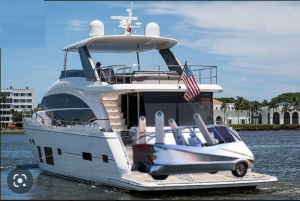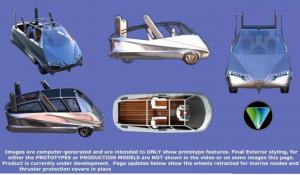The body styles here are subject to change but the underlying technology is the same.

Re-inventing the Gasoline-Powered 1950s Amphicar as a modern electric Car-Boat

Trident LS-1 is the only EV that can be “flat-towed” so no trailer is necessary

Trident LS-1 is an ideal yacht tender: motor to shore and drive around instead of a taxi or ride share.
Innovative Car-Boat EV Hybrid is the Ultimate Practical Solution for Land and Water Travel, Recreation and Other Applications
— Steve Tice – CEO Poseidonamphibworks
SAN DIEGO, CALIFORNIA, UNITED STATES, February 24, 2023 /EINPresswire.com/ — San Diego, CA – Poseidon Amphibworks, an advanced transportation technology startup, announces the launch of its new electric high-performance amphibious hydrofoil vehicle with many potential use cases. The innovative car-boat hybrid is the ultimate practical solution for land and water travel, recreation and other applications, offering a seamless transition between the two and a unique blend of efficiency, versatility, and sustainable mobility.
The Trident LS-1 will be a highway legal land and marine certified for traveling on water. It features “pontoon boat” like features, AWD electric drive and up to 5-inch to 12-inch adjustable height suspension making it “light off-road” capable. The hydrofoil system allows for a smooth, spirited and efficient ride on water, providing an exciting transportation experience. Similar in size to a Tesla model X, the Trident can be easily stored in a typical home garage.
As an electric three-wheel reverse trike autocycle like the well known APTERA being now built in Carlsbad, San Diego, CA, Trident’s powertrain will have a combined projected highway/city range of at least 220 miles (354 kilometers), a top speed projected of ~100 miles per hour (161 kilometers per hour), and estimated 0-60 mph (0-96 km/h) in less than five seconds, making it quite snappy on the street. With the suspension automatically lowered to 5” ground clearance at speeds over 45mph, lower drag and improved handling is expected. It features a center driver seat and two rear seats, plus a fold-down center seat.
Unlike other EVs, Trident LS-1 will be flat-tow “4-wheel down” capable without a trailer; an important capability for the RV target market. This can be a real “marriage saver” if you have ever seen an arguing couple trying to direct each other, attaching a trailer or backing up a trailer down a boat ramp. For flat towing, simply select that mode on the main touchscreen to allow safe flat-towing – RIVIAN electric SUV/pickups promised this feature, but as of the date of this release, that capability is still not supported and no other EV supports that feature today.
Trident LS-1’s projected range as a watercraft should be ~60 miles (96.5 km) at 25mph / 22kts cruise speed, slightly longer at lower speeds but still on foils. It uses strut-mounted hydrofoils that slice through the water lifting up the vehicle out of the water, instead of pushing a large hull. This allows significantly more battery range on a smaller electric powertrain due to water drag reduction of up to 60-80% compared to a non-hydrofoil electric monohull boat. It is projected to have a top speed of 35mph (56.3 kilometers per hour), or ~15mph (24.2 kilometers per hour) without the hydrofoils. On fully extended foils it should handle waves of up to 3.5-4 feet. The ability to travel across coastal waters can reduce the commute time in some cities by bypassing congested highways.
While being a functional vehicle for the streets, the hydrofoil system will give riders an incredibly smooth “magic carpet ride” ($395k Candela delivers the same ride as Trident LS-1) in most water conditions. A significant value to customers is the Trident LS-1 being a great recreational boat with its small pontoon boat features.
On water or on land, soft windows all around and two retractable soft-tops will keep out the elements when required. Camping applications will be supported by modular covered rear deck (seats, tables, other options, etc. can be plugged into different floor locations), with the included sliding soft tops, multi function tailgate and fold down side panels for extra space. For “pontoon boating” on calm water, the driver’s seat swivels 180 degrees, the rear middle seat folds down for an occasional fourth person, and the rear deck is configurable. This is like the electric boating industry’s revolutionary Sea-Doo Switch Compact modular deck pontoon boat but with hydrofoils plus land highway travel capability. Plus the optional camping tent for expanded camping comfort. See pics below.
One of the game changing marine features is the “station keeping” “virtual anchor.” The four computer controlled thrusters will keep the Trident in one position and pointing in one selected heading, eliminating the need for a heavy anchor. This is handy for “newbie” boat captains. Salt water corrosion resistant composites and metals like marine aluminum 5xxx and stainless steel grade 3xx and composites will be the materials to insure trouble free life for these vehicles.
Similar in size to a large SUV like a Tesla Model X, the Trident can be easily stored in a typical home garage. Unlike a boat, it requires no trailer. As a convertible multi-mode/application amphibious vehicle with “idiot-proof” flight-controlled hydrofoils, it has a target price of $95-100K. This is significantly less expensive than other foiling electric watercraft (most e-hydrofoil boats are selling for over $375k) and more convenient for quick outings or trips across lakes or rivers.
Trident LS-1 can be registered as a “motorcycle/autocycle” due to its 3 wheels and including all required features in most regions. This greatly minimizes large development cost and regulatory requirements; however it will have class leading safety features. It is designed as a simple, non-tilting, reverse trike three-wheeled chassis with safety cage, with one electric motor per wheel.
Users can drive it directly into the water from launching ramps. In shallower waters it can travel like a regular electric boat using all four electric thrusters mounted on the bottom of the retractable foil struts. Once the water is deep enough, the hydrofoils extend down. At a ~12mph speed, the hull will rise from the water and the “flight control” system will maintain stability, coordinate banked turns, and so forth at speeds of up to 35+ mph (56 km/h). Future upgrades will include automatic docking.
Because water resistance is so great, 60-80% higher than a monohull electric boat, battery-electric boats typically don’t provide much useful range when pushing a large hull through the water, unless they have large heavy battery packs. Hydrofoils have much less drag because the hull is out of the water. The LS-1 is believed to be the first electric amphibious vehicle to attempt this technology.
The Trident LS-1 under development is currently the world’s only hydrofoil-enhanced amphibious electric autocycle vehicle. It has the potential to impact transportation (ride-sharing, water taxis, cargo, bypassing traffic), recreational markets and search and rescue operations. The San Diego-based startup believes amphibious vehicles are a key component in adapting to a world altered by climate change.
The company believes a secondary demand for their vehicles will grow for amphibious vehicles. As sea levels rise, dual role vehicles will become more of a necessity rather than a luxury. Poseidon’s presence in Florida is no accident. Southern Florida and the New Orleans area are expected to be some of the worst affected as sea level rise accelerates over the next few decades. Various estimates point to sea levels rising by 1 to 8 feet by 2050 or 2100. The company said that as hurricane-induced flooding becomes an increasing problem — highlighted by recent devastation in Florida — consumers will seek solutions.
“Having an amphibious vehicle that can be used for commuting and as family recreation, can also be a lifesaver when the unexpected happens,” said Steve Tice, CEO/CTO of Poseidon AmphibWorks. “However, the amphibious vehicles on the market today are all fossil-fuel powered. They are either great for offshore performance but can only be legally used for light off-road, or low performance on both water and land. or highway legal, good performance on water but have limited applications, are gas powered and all very expensive.
The Trident LS-1 represents a NEW MODE of PRACTICAL FUTURE transportation. It is a testament to our commitment to creating sustainable, efficient, versatile vehicles that REPRESENT A REAL VALUE PROPOSITION to a broader group of customers that will change the way people travel in many water adjacent regions.”
There are only a few amphibious vehicles and $350+k electric hydrofoil boats now on the market, but there is currently no such product that combines our two capabilities, especially at a reasonable price point, so Poseidon will serve a market with no direct competitors.
Leading industry experts, including GearJunkie, New Atlas, and Autoevolution, have already praised the Trident LS-1 for its innovative design, projected performance and value proposition to the customer.
For more information, please visit the following links:
Latest Trident LS-1 Operations Video – https://vimeo.com/791999857
Flight control hydrofoil system prototype video – https://vimeo.com/742794636
Best Article iMedia – https://lnkd.in/gYJ32PiR
SDBJ article – https://www.sdbj.com/featured/poseidon-amphibworks-launches-to-bring-evs-to-land-and-sea/
GearJunkie article – https://gearjunkie.com/motors/poseidon-amphibworks-trident-ls-1 New Atlas article – https://newatlas.com/marine/poseidon-amphibworks/
Autorevolution article
– https://www.autoevolution.com/news/poseidon-amphibworks-ls-1-is-an-electric-car-that-floats-and-flies -over-water-201324.html
DesignBoom article
– https://www.designboom.com/technology/amphibious-electric-three-wheeler-trident-ls-1-poseidon-amphi bworks-10-17-2022/
TRIDENT LS-1 SUMMARY OVERVIEW – EV Show Banner – https://www.dropbox.com/s/zg8npi7z5rfmqzz/FULL_CHARGED_LIVE_Banner.pdf?dl=0
ABOUT POSEIDON AMPHIBWORKS
POSEIDON AMPHIBWORKS CORPORATION is an electric vehicle and marine engineering driven company focusing on filling the current void for affordable, high-performance, high-efficiency and multi-function electric amphibious vehicles. Poseidon AmphibWorks has assembled a deeply-experienced team of world class marine engineering firms, as well as groups with superb experience in low-volume & optimized manufacturing, and electric powertrains. Co-founder Capt. Andy Langesfeld (Amphibious Vehicle Consulting http://car-boat.com) and Steve Tice, founder of https://QuantumWorks.com, teamed up to form this new company Jan 2022, (a spin-off project from QuantumWorks), to devote specific project work starting in 2021. Poseidon AmphibWorks products are in the prototype design stage of development. The riskiest portion, the hydrofoils flight control system, has already been successfully prototyped and tested. Prominent Design for Manufacturing & Assembly Lean Design and Electric Vehicle manufacturing design experts, such as Sandy Munro and Munro & Associates and marine design experts are on the Advisory Board.
Steve Tice
Poseidon Amphibworks
+1 619-438-0018
steve@poseidonamphibworks.com
Visit us on social media:
Facebook
Twitter
LinkedIn
Instagram
Trident LS-1 Boat Dock – Land to Water to Land
![]()
Article originally published on www.einpresswire.com as Poseidon AmphibWorks Unveils Next Generation of Transportation

